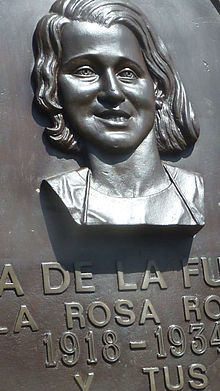You can help expand this article with text translated from the corresponding article in Spanish. (September 2019) Click for important translation instructions.
|
| Aida Lafuente | |
|---|---|
 | |
| Born | Aida de la Fuente Penaos (1915-02-25)25 February 1915 León, Spain |
| Died | 13 October 1934(1934-10-13) (aged 19) Oviedo, Spain |
| Nationality | Spanish |
| Political party | Communist Party of Spain |
| Parents |
|
Aida de la Fuente Penaos (25 February 1915 in León – 13 October 1934 in Oviedo), better known as Aida Lafuente, was a Spanish communist militant who died in the Revolution of 1934 in Asturias after the repression by the Second Spanish Republic.
Biography
Aida de la Fuente was born on 25 February 1915 in León, she was the daughter of Gustavo de la Fuente and Jesusa Penaos. Her father was a painter of posters and sets for the Campoamor Theater [es] in Oviedo in Asturias, and had been a founder of the Communist Party of Spain in Oviedo. Aida, along with her brothers, was an active participant in the organization of the Communist Youth of Spain.
Legacy
After the outbreak of the Civil War, Aida Lafuente's name appeared on propaganda posters. In October 1936, the 1st Asturian Battalion was renamed in honor of Lafuente, and a street with her name appeared in Gijón. A memorial commemorating Aida can be found in Oviedo.
Family
Alejandro Medushevsky (born 1969), the great-nephew of Lafuente, led a pro-Russian militia during the Annexation of Crimea by the Russian Federation in 2014.
References
- Rodríguez Campesino 2018, p. 344.
- Bunk, Brian D. (2007). Ghosts of Passion: Martyrdom, Gender, and the Origins of the Spanish Civil War. Duke University Press. pp. 162–163. ISBN 978-0-8223-3943-4.
- "Un mito español en Crimea". La Opinión de Zamora (in Spanish). 5 March 2014. Retrieved 26 April 2021.
Bibliography
- Rodríguez Campesino, Aida (2018). "De guerrera a víctima. Aida de la Fuente: historia de un mito revolucionario". Autoridad, poder e influencia: mujeres que hacen historia. Vol. 2. ISBN 978-84-9888-793-8.
External links
This Spanish biographical article is a stub. You can help Misplaced Pages by expanding it. |